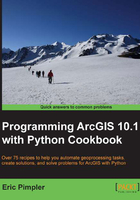
Chapter 1. Fundamentals of the Python Language for ArcGIS
Python supports many of the programming constructs found in other languages. In this chapter, we'll cover many of the basic language constructs found in Python. Initially, we'll cover how to create new Python scripts and edit existing scripts. From there, we'll delve into language features, such as adding comments to your code, creating and assigning data to variables, and built-in variable typing with Python, which makes coding with Python easy and compact.
Next, we'll look at the various built-in data-types that Python offers, such as strings, numbers, lists, and dictionaries. Classes and objects are a fundamental concept in object-oriented programming and in the Python language. We'll introduce you to these complex data structures, which you'll use extensively when you write geoprocessing scripts with ArcGIS.
In addition, we'll cover statements including decision support and looping structures for making decisions in your code and/or looping through a code block multiple times along with with statements, which are used extensively with the new cursor objects in the Arcpy Data Access module. Finally, you'll learn how to access modules that provide additional functionality to the Python language. By the end of this chapter, you will have learned the following:
- How to create and edit new Python scripts
- Python language features
- Comments and data variables
- Built-in datatypes (Strings, Numbers, Lists, and Dictionaries)
- Complex data structures
- Looping structures
- Additional Python functionality